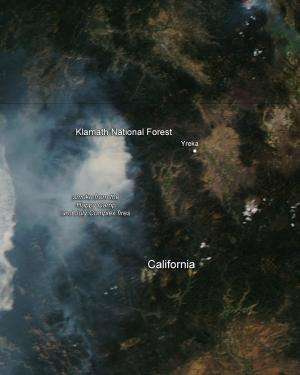NASA image: Happy Camp and July Fire Complexes in California

As of seven hours ago the Happy Camp Complex of fires had consumed 24,939 acres of land in Northern California, the July complex had consumed 35,530 as of eight hours ago.
Lightning strikes started seventeen fires on the Happy Camp Ranger District of the Klamath National Forest when a thunderstorm passed through the area on August 11, 2014. All but three of those fires are now 100 percent contained. The following is a list of contained fires and their size at containment: Delta, 150 acres; Sutcliffe, 27 acres; Jackson, 21 acres;Thompson, 17 acres; Tims, 13 acres; Ranch, 6 acres; Huckleberry, 5 acres; Bear, 4 acres; China, 3 acres; Mill, 2 acres; Noranda, 1 acre; Luther 1, 0.4 acre; El Capitan, 0.2 acre; Luther 2, 0.1 acre. Firefighters are still working to suppress the Frying Pan Fire (22,410 acres, 20 percent contained), Faulkstein Fire (2,194 acres, 0 percent contained), and Kemper Fire (185 acres, 85 percent contained). Total personnel on this fire is 1,839. Committed resources include 57 crews, 8 helicopters, 91 engines, 16 dozers, 23 water tenders.
The July complex consists of the Whites, Leef, Rays and Man Fires. The Leef fire at 17 acres is 100% contained and in patrol status, the Rays fire is 100% contained at 21 acres. The Whites Fire has increased fire activity in the current fire perimeter due to the hot, dry conditions. Creeping and smouldering with single tree torching has been observed along with short fire runs which occurred with the favorable wind and weather conditions for fire spread. Today (8/27) is the first day of a four day hot and dry period in the region.
The Man Fire was subsumed into the July complex after its start with a lightning strike on August 12 and is estimated at 535 acres. Firefighters will use minimal impact suppression tactics to contain this fire. The Man Fire continued to burn actively in the Wooley Creek and Big Elk Fork drainage areas. General growth of the fire is west southwest at a slow to moderate rate of spread.
This natural-color satellite image was collected by the Moderate Resolution Imaging Spectroradiometer (MODIS) aboard the Aqua satellite on August 26, 2014. Actively burning areas, detected by MODIS's thermal bands, are outlined in red.
Provided by NASA's Goddard Space Flight Center





















